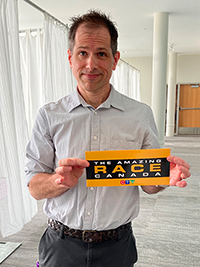News and Updates
Contact
Faculty of Social Science
Social Science Centre
Room 9438
Western University
T. 519-661-2053
F. 519-661-3868
E. social-science@uwo.ca
Western tests minds of The Amazing Race Canada teams during neuroscience challenge
August 17, 2022
 The Amazing Race Canada is airing on CTV all summer long. On August 16, racers made their way to Western University where viewers got a glimpse of the neuroscience research happening at the research-intensive institution.
The Amazing Race Canada is airing on CTV all summer long. On August 16, racers made their way to Western University where viewers got a glimpse of the neuroscience research happening at the research-intensive institution.
Racers arrived at the Western Interdisciplinary Research Building, home to world-class neuroscience research, to try their hand at a meditation challenge, using neurotechnology called a Muse® headset.
The meditation challenge was adapted from research conducted in Dr. John Paul Minda’s lab at Western. Minda is a cognitive neuroscientist and psychologist specializing in thinking and decision-making. His innovative research is helping to understand how mindfulness meditation affects the brain.
Minda sat down with Western News to discuss his research and experience on The Amazing Race Canada.
What was your experience being on the set of The Amazing Race Canada?
Dr. John Paul Minda: The experience was unique for me! I was given the clue-giver role, so I welcomed and directed the racers. I also checked their scores to let teams know when they reached 30 ‘calm points’ identified by the Muse headset so they could move on to the next part of the race.
It was a lot of fun, and it was incredible to see the work that went into the episode – not just from the larger production company, but also from people at Western and the London area. It was great to be a part of it.
What made this challenge difficult for the racers?
JPM: What we were asking the racers to do was to try to calm their mind in a particular way that would not be at all what they would be expecting to do in a race. Usually, they’re working on adrenaline or trying to do something that's physically challenging or demanding.
Our meditation challenge was primarily mentally demanding. They had to sit still and calm their thoughts. They had to focus on their breathing and notice if their attention wandered. All of those things are a real challenge, and to do it in a competitive environment while people are watching you, it would have been even more difficult because there's so many things to pay attention to.
That’s one of the reasons why we think it was a good and novel challenge. This kind of challenge is possible in a neuroscience research facility. The racers might not be able to do this kind of thing in other environments.
What were the factors that helped racers excel at this challenge?
JPM: I think there's a lot of things that could potentially help someone excel at this challenge. One obvious one would be if any of the racers were familiar with mindfulness, meditation or contemplative practices and had some experience in them. That might give them an advantage.
Another would be other kinds of mental training. If a team has a background in a certain kind of performance, or performance discipline that emphasizes long periods of focus, that could give them an advantage.
Also, the way the challenge was set up was that racers needed to cumulatively achieve a certain number of points. If one achieved only 10 per cent and the other achieved 90 per cent, they could still do well. From that perspective, if a team is used to working together, that could also be an advantage. I noticed this in some of the racers. Knowing that you’ve got someone who is more successful at achieving the points might help the other racer calm down and focus.
What’s the science behind the Muse headset?
JPM: The Muse headset is a mobile electroencephalogram (EEG) device that takes advantage of the electrical impulses that neurons create and communicate with each other. Since a neuron has electrical potential, you can measure that with a sensor that’s placed close to the scalp.
The headset uses seven calibrated sensors – two on the forehead, two behind the ears and three reference sensors. The sensors pick up fluctuations in the brain between the prefrontal area of the cortex, and the dorsolateral prefrontal cortex, which is where most of us are going to see some additional activation when we’re focused on a goal.
If your mind starts to wander, then you’re going to see activations spread across the brain. The Muse devices are too small to pick up whole brain activity, but what they can pick up is the differential between activation on that frontal part and the temporal part of the brain. When there’s more activation back and forth, it notices that you’ve lost focus, and that maybe you’re thinking about other things.
When you refocus your attention, the headset picks up on that ability and sends a Bluetooth signal to the device that it’s connected to. This tells the device software to change what you’re listening to. In our case, the racers were listening to what sounded like being at the lake or at the beach. They would hear some waves and some wind, and occasionally they could hear little bird tweets.
If your mind starts to wander and the device picks up that differential between the temporal and frontal lobes, it increases the intensity of the wind, the intensity of the waves, and it can even sound like there’s a rainstorm with thunder. The more you let your mind wander, the more active the sound is. If you refocus your attention on your breathing, the device picks up that additional activation in the frontal cortex. Then it translates it into calmer sounding wind and waves.
If you can get that calm sound long enough, then you start to hear a little bird tweet. That tells you that you’ve achieved a certain amount of focus and mental calmness. In the Amazing Race Canada challenge that’s what we were scoring – we were listening to the number of birds the racers heard.
In a nutshell, the device measures electrical brain activity, and translates that electrical activity into auditory feedback, so that in real time, the user can hear an auditory analogue to the activity in their brain. It helps guide people through their meditation practice.
Why was Western’s neuroscience research chosen for this challenge?
JPM: I think the show was interested in neuroscience for two reasons.
We have a lot of great departments and programs at Western, but we are really strong in neuroscience – we’ve got really good clinical, imaging and cognitive neuroscience work. We're also going to be reaching a new expanded range now that we've launched the Western Institute for Neuroscience.
I also think neuroscience lent itself well to a challenge that was competitive and novel. It was something different.
Tell us about your research in this area.
JPM: My research addresses two big questions. The biggest question is how people organize their experiences into concepts, and then how they use those concepts to make decisions, plan and solve problems. It focuses on mental organization.
I started working with mindfulness and meditation about five or six years ago as another way to understand what people think about. One of our studies found that mindfulness practice is one way in which people could get better at not blaming themselves for things. Another found that people who score naturally high on mindful cognition was predictive of their ability to not be susceptible to biases.
Where we wanted to go with that more recently is using the functional near-infrared spectroscopy system (fNIRS) to look at the difference between explicit mind wandering – so telling people to just let your mind wander – and also focusing attention on certain things. The study involves a whole brain analysis. The preliminary data seems to suggest that there is additional activation in the frontal area when participants are told to be mindful. When they're told to let their mind wander, we see activation instead in those other areas. In this study, it was parietal area of the brain. So, what we're trying to do is use sophisticated neurotechnology neuroimaging to look at different brain states of activation when people switch between focused attention, awareness and mind wandering.
How can mindfulness research help those suffering from neurodegenerative diseases and disorders?
JPM: With obsessive compulsive thoughts, but also post-traumatic stress disorder and trauma, where people have recurring thoughts, meditation can be a common and effective treatment. It can also help with anxiety.
There's a lot of potential for understanding meditation at the neural level. Understanding how and why it might have the effects that it does is crucial. If we can understand how meditation is different from other kinds of therapeutic interventions or other kinds of interventions, we can better help people.

